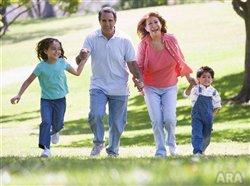Foot care tips to keep boomers moving
 Just a few decades ago, the phrase “granny shoes” implied a tragic lack of coolness, and that the wearer had allowed comfort to trump style in their slow shuffle toward getting old. Those days are definitely gone.
Just a few decades ago, the phrase “granny shoes” implied a tragic lack of coolness, and that the wearer had allowed comfort to trump style in their slow shuffle toward getting old. Those days are definitely gone.
Today’s baby boomers and seniors are stepping out in everything from frisky flip-flops and hot heels to righteous running shoes and powerful hiking boots. Footwear is no longer dictated by age, but rather by the activity level and fashion sense of the wearer.
Still, like everything else about our bodies, our feet change with age. Because of this, the steps we take to keep them healthy have to adjust accordingly.
“While staying active is a great way to preserve overall health and can positively impact foot health, aging can naturally increase the risk of certain foot ailments,” says Joseph Caporusso, DPM, a podiatrist and president of the American Podiatric Medical Association (APMA). “It’s important to know the symptoms of age-related foot ailments and take steps to minimize their impact on your overall health.”
APMA offers some information on common foot ailments to watch for as you age:
Arthritis
While many health issues can cause arthritis, and it can affect people of any age, those older than 50 are most prone to it. The feet are more susceptible to this painful inflammation of the cartilage and lining of the joints because each foot has 33 joints – all of which help bear the weight of the entire body every day. Arthritic feet can lead to a loss of mobility if the condition is not diagnosed and treated.
The causes of arthritis can range from heredity to injuries to bacterial or viral infections that affect the joints. Arthritis may take several forms, so if you’re experiencing foot pain, it’s best to have it diagnosed by a podiatrist. Symptoms that indicate it’s time to see the doctor include:
* Swelling in one or more joints
* Recurring pain or tenderness in any joint
* Redness or heat in joints
* Loss of mobility in a joint
* Stiffness in the early morning
* Skin changes such as rashes or growths
Arthritis can be treated, but early diagnosis is important. Treatment options may include physical therapy, exercise or medication.
Diabetes
Foot-related complications are common among the nearly 26 million Americans who have diabetes. Proper diet, exercise, medical care and careful home management can help people with diabetes avoid the most serious complications of the disease, including amputation.
In addition to regular checkups with their podiatrist, people with diabetes can reduce their risk of complications with some basic foot care, including:
* Inspecting their feet daily.
* Choosing thick, soft socks without seams that could rub or cause blisters.
* Exercising daily.
* Having new shoes properly measured and fitted.
* Avoiding going barefoot.
* Seeing a podiatrist for treatment of calluses, corns or warts, rather than trying to treat these conditions themselves.
High blood pressure
Hypertension can be related to a buildup of plaque in the blood vessels, a condition which can lead to decreased circulation in the legs and feet. Poor circulation can lead to the development of open wounds on the skin. Symptoms of poor circulation in the feet and legs include cramping, sores that take a long time to heal, changes in the color or temperature of the feet, and loss of hair on the feet and legs.
Heel pain
One of the most common foot complaints, heel pain can be caused by walking gait abnormalities, an injury, wearing poorly constructed footwear over the long term, or being overweight.
Heel pain is often very treatable. A podiatrist can examine the heel, and may take X-rays to rule out bone problems as the source of the pain. Treatment may include anti-inflammatory medication, exercise and shoe recommendations, taping or strapping, or use of shoe inserts or orthotic devices.
To minimize risks of developing heel pain, wear shoes that fit well and have shock-absorbent soles, rigid shanks and supportive heel counters. Wear the proper type of shoe for the activity you’ll be doing. Warm up before exercising, and pace yourself while participating in athletic activities.
“Foot pain does not need to be an inevitable part of growing older,” Caporusso says. “Wearing the right type of footwear for your needs, and paying attention to foot health can help keep boomers moving into their senior years.”


















